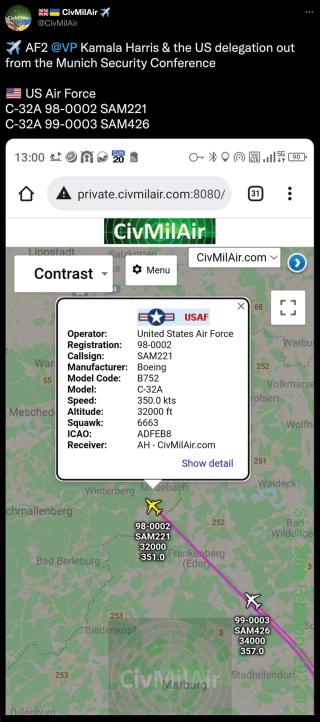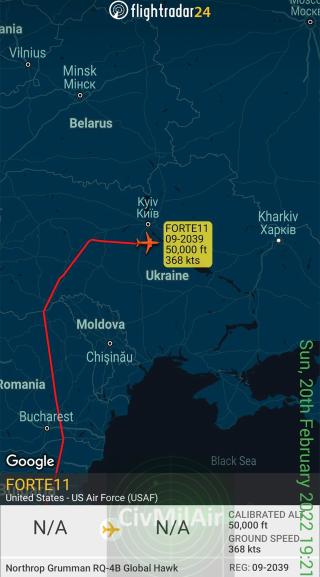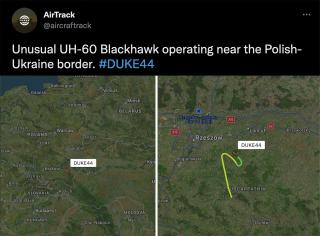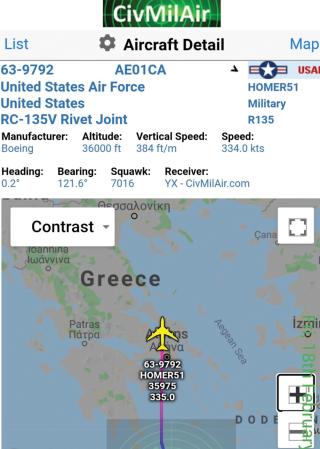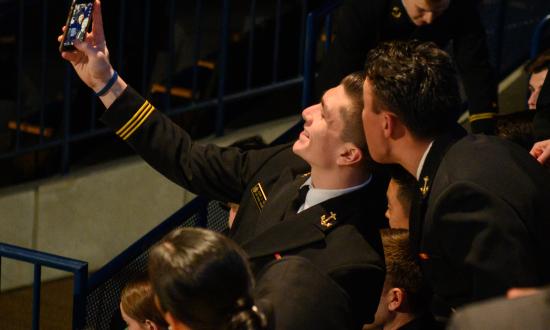A foreign adversary excitedly zooms in on the location of an RQ-4 Global Hawk operating over Eastern Europe. He screenshots the image on his phone and hurries back to the command suite. “Sir, the American drone is back.” The commander orders the acquisition radar to orient on the bearing indicated by the screenshot and quickly finds the target. Seconds later, a surface-to-air missile speeds toward the aircraft.
The adversary’s high-value intelligence source in this scenario: Twitter.
At present, dozens of U.S. military aircraft—both manned and unmanned—have their locations, altitudes, callsigns, and other identifying information accessible on the Twitter platform in near-real time. These social media posts gather open-source information from multiple plane tracking websites that can access unencrypted aircraft transponder data. Recent posts on Twitter’s military air tracking pages included the live locations of a B-52 Stratofortress, RC-135 Rivet Joint, WC-135 Constant Phoenix, and EC-130 Compass Call electronic attack aircraft.
Adversaries no longer need to rely on expensive radars to find U.S. military aircraft. The accessibility of this information demands a review of U.S. military operational security practices.
Lesson from Ukraine
The war in Ukraine has highlighted the risk of having U.S. military flight data in the public domain. When NATO allies started providing antitank missiles to Ukraine, the weapons’ movement on board U.K. aircraft was visible and highlighted by Twitter flight trackers.1 Multiple U.S. C-17 flights from Fort Bragg and Pope Air Force Base were tracked as well. Twitter users speculated about what cargo or personnel were being moved.
U.S. intelligence aircraft operating in or moving toward Eastern Europe also were discovered and characterized. These include the Artemis 650 intelligence, surveillance, and reconnaissance aircraft, multiple MQ-4 Tritons, an EC-130, and an RC-135.2
Information on the location and disposition of U.S. aircraft is valuable to adversaries. One can imagine any number of scenarios in which knowing the precise location and altitude of an aircraft could lead to loss of life or an information advantage to an adversary.
Tactical aircraft such as helicopters also are susceptible to tracking. A likely U.S. Army UH-60 Blackhawk was observed conducting operations or training in proximity to the Poland-Ukraine border.3 In another instance in late February 2022, a group of Royal Air Force Chinook helicopters was observed transiting over Germany.
Open Sources
For anyone with access to the internet, flight information is available from multiple open sources. Most prevalent is the Automatic Dependent Surveillance–Broadcast (ADS-B). ADS-B transceivers on aircraft transmit their locations to ground stations and other aircraft. Some also can transmit this information via satellite, resulting in near worldwide coverage. The intent is to facilitate situational awareness for pilots and fill in coverage gaps in ground-based air traffic control radars.
The Federal Aviation Administration (FAA) requires ADS-B transmitters in Class A, B, and C airspace within most of the continental United States and Alaska. Class A airspace extends from 18,000 feet to 60,000 feet mean sea level (MSL). Class B airspace is that surrounding major airports from ground level up to 10,000 feet MSL. Class C airspace is the area around an airport with a control tower or with radar approach control. Outside the United States, ADS-B requirements vary but generally are expanding worldwide.4
Because ADS-B transmissions are unencrypted they are trackable, not just by aviation authorities, but also by the public. Several flight tracking websites make this near-real-time information accessible. Numerous Twitter feeds are dedicated to tracking military aircraft, especially in conflict zones, using this information to create posts. The Twitter users vary from aircraft enthusiasts and political commentators to extremist groups and nonstate actors interested in tracking the movements of their adversaries. Sometimes comments on an aircraft’s movement or activity include support of violent action by extremist actors or nation-states.
Alarmingly, in February 2022, an air convoy of Boeing C-32s carrying the Vice President was tracked heading from Munich following a series of meetings with NATO allies about the security situation in Eastern Europe.5 The post was liked 46 times and reshared 17 times—and viewed an unknown number of times by others. Also tracked flying from Munich the day before was the British Prime Minister, and on 19 February, the U.S. Secretary of Defense flying home from Lithuania. The flight trackers observe domestic flights as well, noting the President of the United States traveled from Andrews Air Force Base to New York on 3 February 2022 on board a Boeing VC-25A.
Compromise Needed
The information adversaries can derive from unsecured aviation data is far too revealing of mission-critical operations and movements. The Department of Defense (DoD), FAA, and other stakeholders need to reach a compromise that better balances aircraft safety and operational security. This agreement also should be coordinated with international air safety organizations such as the European Union Aviation Safety Agency and perhaps NATO as a standard operating procedure. A possible compromise could entail a peacetime mode in which ADS-B altitude and bearing data is transmitted but identifying information harmful to operational security is stripped out and a wartime mode in which DoD reserves the right to turn off ADS-B transponders in the vicinity of conflict zones.
Controlling this small portion of the information spectrum is critical to force protection. A better balance can be struck to ensure the safety of domestic and international airspace without leaking the essential operations information of U.S. military aircraft. Working together, the FAA and DoD could modify and promulgate rules that account for operationally sensitive activities, including national leaders’ travel and military movements in operational theaters.
twitter.com/CivMilAir/status/14945017799999201281. John Vandiver, “British C-17s Carrying Arms to Ukraine Fly around German Airspace,” Stars and Stripes, 18 January 2022.
2. @CivMilAir, “Taking over the Watch @ 52,000ft over #Ukraine,” Twitter, 20 February 2022, twitter.com/civmilair/status/1495479055688384516?lang=en; and @CivMilAir, “Early Start . . . HOMER61 out from Souda Bay,” Twitter, 18 February 2022, twitter.com/CivMilAir/status/1494501779999920128.
3. @Aircrafttrack, “Unusual UH-60 Blackhawk operating near the Polish-Ukraine border,” 21 February 2022, #DUKE44, mobile.twitter.com/aircraftrack/status/1495750729604243458/photo/2.
4. Federal Aviation Administration, “ADS-B: Frequently Asked Questions,” 26 January 2022, www.faa.gov/air_traffic/technology/adsb/faq/.
5. @CivMilAir, “AF2 @VP Kamala Harris & the U.S. Delegation out from the Munich Security Conference,” Twitter, 20 February 2022, twitter.com/CivMilAir/status/1495383924155027458.




